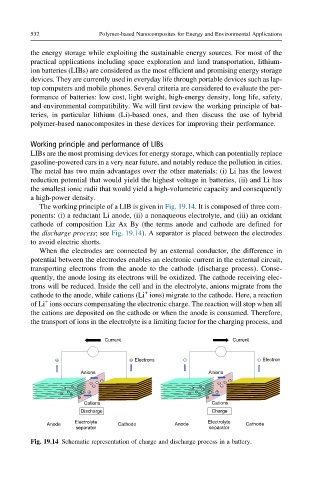Page 579 - Polymer-based Nanocomposites for Energy and Environmental Applications
P. 579
532 Polymer-based Nanocomposites for Energy and Environmental Applications
the energy storage while exploiting the sustainable energy sources. For most of the
practical applications including space exploration and land transportation, lithium-
ion batteries (LIBs) are considered as the most efficient and promising energy storage
devices. They are currently used in everyday life through portable devices such as lap-
top computers and mobile phones. Several criteria are considered to evaluate the per-
formance of batteries: low cost, light weight, high-energy density, long life, safety,
and environmental compatibility. We will first review the working principle of bat-
teries, in particular lithium (Li)-based ones, and then discuss the use of hybrid
polymer-based nanocomposites in these devices for improving their performance.
Working principle and performance of LIBs
LIBs are the most promising devices for energy storage, which can potentially replace
gasoline-powered cars in a very near future, and notably reduce the pollution in cities.
The metal has two main advantages over the other materials: (i) Li has the lowest
reduction potential that would yield the highest voltage in batteries, (ii) and Li has
the smallest ionic radii that would yield a high-volumetric capacity and consequently
a high-power density.
The working principle of a LIB is given in Fig. 19.14. It is composed of three com-
ponents: (i) a reductant Li anode, (ii) a nonaqueous electrolyte, and (iii) an oxidant
cathode of composition Liz Ax By (the terms anode and cathode are defined for
the discharge process; see Fig. 19.14). A separator is placed between the electrodes
to avoid electric shorts.
When the electrodes are connected by an external conductor, the difference in
potential between the electrodes enables an electronic current in the external circuit,
transporting electrons from the anode to the cathode (discharge process). Conse-
quently, the anode losing its electrons will be oxidized. The cathode receiving elec-
trons will be reduced. Inside the cell and in the electrolyte, anions migrate from the
+
cathode to the anode, while cations (Li ions) migrate to the cathode. Here, a reaction
+
of Li ions occurs compensating the electronic charge. The reaction will stop when all
the cations are deposited on the cathode or when the anode is consumed. Therefore,
the transport of ions in the electrolyte is a limiting factor for the charging process, and
Current Current
Electrons Electron
Anions Anions
Cations Cations
Discharge Charge
Electrolyte Electrolyte
Anode Cathode Anode Cathode
separator separator
Fig. 19.14 Schematic representation of charge and discharge process in a battery.

